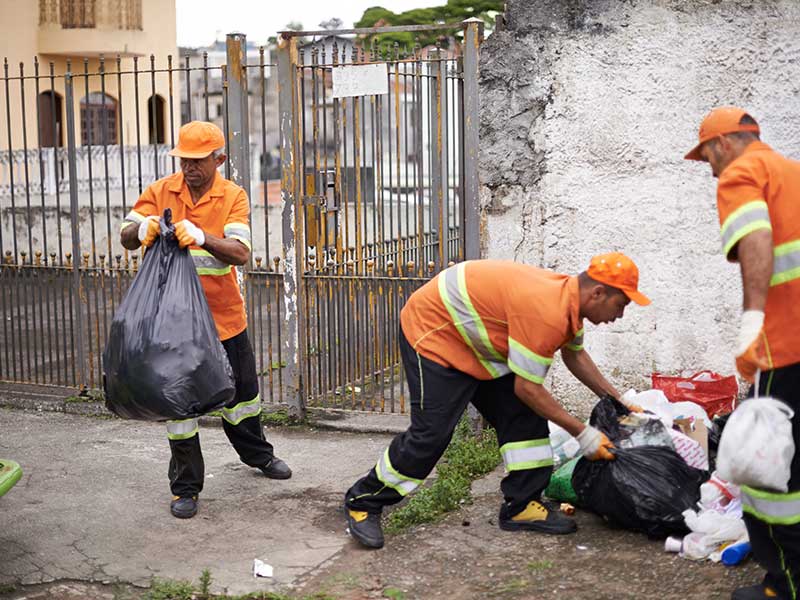More than nine percent of American workers abuse alcohol or drugs and suffer from a substance use disorder, according to the National Survey on Drug Use and Health. Substance abuse contributes to lost productivity, accidents, injuries and increased rates of illness. The economics losses are in the billions of dollars.
Drug and Alcohol Abuse Among U.S. Workers
Studies indicate that men misuse drugs more often than women, and younger adults abuse drugs more often than older adults. Thus, industries with more males or younger adults tend to have higher rates of drug abuse. Other factors that influence the prevalence of drug use among workers include wages and geography.
Prescription drug abuse is included in the illicit drug use category, and heavy drinking is defined as drinking five or more drinks in one day during five separate occasions in a single month.
- 8.7 percent of full-time adult workers aged 18 to 64 used alcohol heavily in the past month.
- 8.6 percent used illicit drugs in the past month.
- 9.5 percent were dependent on or abused alcohol or illicit drugs in the past year.
Doctors and Health Care Professionals
An estimated 10 percent of health care professionals abuse drugs — about the same rate as the general public. However, studies suggest that doctors are more likely to misuse prescription drugs than their patients.
Most doctors don’t abuse drugs for the fun of it, though. The most common reasons physicians use prescription drugs are to manage physical pain, emotional distress and stressful situations.
Different types of doctors are more likely to abuse different types of drugs. A 1999 study published in the Journal of Addictive Diseases compared drug use by health care professions, finding psychiatrists and emergency room doctors used drugs the most. Surgeons used drugs the least.
- Emergency room doctors used the most illicit drugs.
- Psychiatrists used the most benzodiazepines.
- Pediatricians had low rates of drug use.
- Surgeons had low rates, except for tobacco smoking.
- Anesthesiologists had high rates of opioid abuse.
More recently, a 2012 study of American surgeons published in JAMA Surgery found 15.4 percent suffered from an alcohol use disorder. Female surgeons (25.6 percent) were more likely than male surgeons (13.9 percent) to exhibit symptoms of alcohol addiction.
The consequences of the alcohol problems were frightening. Surgeons who reported feeling burned out or depressed were the most likely to have an alcohol use disorder, as were surgeons who reported making a major medical error within the previous three months.
Struggling with an addiction in your profession?
We have programs designed specifically for you.
Attorneys and Lawyers
Young lawyers face an enormous amount of stress, large debt payments and a shrinking market for entry-level jobs coming out of college. That may be why about 29 percent of lawyers in their first decade of practice report problematic drinking behavior. Comparatively, 21 percent of attorneys in their second decade of practice suffer from alcohol use disorders.
Problematic drinking often begins during law school, but 44 percent of lawyers with alcoholism report drinking problematically for the first time during their first 15 years of practice.
Lawyers in law firms abuse alcohol at the highest rate, and junior associates have the highest rate of problematic drinking behavior. The statistics come from a 2014 joint study conducted by the American Bar Association and the Hazelden Betty Ford Foundation.
In the last decade, the ABA and other bar associations began analyzing the billable-hour payment method that was linked to exhaustion and burnout. Since the recession, the use of billable hours has decreased substantially. Law schools have also increased efforts to help students evaluate prospective career paths before beginning coursework.
Drug Use by Industry
The Substance Abuse and Mental Health Services Administration uses National Survey on Drug Use and Health data to compare rates of heavy alcohol use, illicit drug use and substance use disorders by industries. The industries are categorized using the North American Industry Classification System.
Drug Use in Accommodations and Food Services
The accommodations and food services industry is composed of hotels, restaurants, bars, food-service contractors and other eating places. Workers in the industry provide lodging or prepare food, beverages and meals for immediate consumption.
The profession leads all industries in past-month illicit drug use and past-year substance use disorder categories by a significant margin. It ranks third in heavy alcohol consumption, behind mining and construction.
Rates of Substance Use in the Accommodations and Food Services Industry
| Category |
Rate |
Trend (2008 to 2012) |
| Past-month heavy alcohol use |
11.8% |
Down 0.7% |
| Past-month illicit drug use |
19.1% |
Up 2.1% |
| Past-year substance use disorder |
16.9% |
Down 0.5% |
There isn’t one drug that these workers abuse most often. Employees may abuse depressants such as alcohol or marijuana in order to relieve stress or take stimulants such as cocaine or amphetamines to stay awake during long shifts.
High rates of drug use are likely related to a number of risk factors: high-stress work environments, low wages, young employees, high-turnover positions and irregular hours.
Drug Use in Arts, Entertainment, and Recreation
The category of arts, entertainment and recreation comprises amusement parks, gambling facilities, performing arts centers, musical groups, spectator sports, museums, theaters and historical sites. Employees include entertainers, athletes and promotional agents or managers.
The line of work ranks second in past-month illicit drug use, third in past-year substance use disorder rates and fourth in heavy alcohol use.
Rates of Substance Use in the Arts, Entertainment and Recreation Industry
| Category |
Rate |
Trend (2008 to 2012) |
| Past-month heavy alcohol use |
11.5% |
Down 1.4% |
| Past-month illicit drug use |
13.7% |
Up 0.8% |
| Past-year substance use disorder |
12.9% |
Down 0.1% |
Employees abuse a variety of drugs for many of reasons. These professions receive the most attention for celebrity overdoses and visits to rehab. However, the industry’s larger layman workforce is just as likely to suffer consequences of drug abuse as their famous counterparts.
Risk factors in the industry include long hours, high turnover, high-pressure jobs, young workers and workplace cultures conducive to illicit drug use.
Drug Use in Mining
The mining, quarrying and oil and gas extraction industry includes companies that retrieve naturally occurring chemicals. Workers in the industry quarry, well, crush, screen, wash and prepare minerals at mining and drilling sites.
Mining leads all industries in past-month heavy alcohol use and ranks fourth for past-year substance use disorder rates. However, past-month illicit drug use rates are the third lowest of all industries.
Rates of Substance Use in the Mining Industry
| Category |
Rate |
Trend (2008 to 2012) |
| Past-month heavy alcohol use |
17.5% |
Up 1.3% |
| Past-month illicit drug use |
5.0% |
Down 2.4% |
| Past-year substance use disorder |
11.8% |
Down 2.5% |
Alcohol is by far the most common substance of abuse in the mining industry. The U.S. Mine Safety and Health Administration developed educational, screening and incentive programs to deter alcohol abuse, yet rates of alcohol abuse grew from 2003 – 2007 to 2008 – 2012.
Roster systems may contribute to the problem. Miners usually work for two to three weeks and then take one week of leave. It is during this time away from workplace prevention efforts that heavy alcohol consumption typically occurs.
Looking for help with your addiction?
Learn about our online substance abuse treatment offerings.
Learn About Teletherapy
Drug Use in Construction
Employees in the construction industry build residential and nonresidential buildings, infrastructure and utility systems. They may also work in civil engineering or for equipment providers. Laborers may produce new work, provide maintenance or make repairs.
The industry is second to mining for rates of heavy alcohol consumption and fourth in rates of illicit drug use. Construction is also second in the percentage of employees who suffer from substance use disorders.
Rates of Substance Use in the Construction Industry
| Category |
Rate |
Trend (2008 to 2012) |
| Past-month heavy alcohol use |
16.5% |
Up 0.9% |
| Past-month illicit drug use |
11.6% |
Down 2.3% |
| Past-year substance use disorder |
14.3% |
Down 3.0% |
Construction requires intense labor, long hours and unpleasant work environments. The conditions can cause soreness, aches and chronic pain. Workers may self-medicate with prescription pain relievers or turn to alcohol and drugs to deal with work-related stress.
Drug Use in Admin, Support, Waste Management and Remediation Services
Administrative, support, waste management and remediation services include employment agencies, travel arrangement providers, security companies, and waste management and remediation organizations. Jobs in the industry include administration, clerical, solicitation, collection, cleaning and waste disposal work.
More than one out of every 10 workers in the industry suffered from a substance use disorder in the past year. The professions have the third highest rate of past-month illicit drug use.
Rates of Substance Use in the Admin, Support, Waste Management and Remediation Services Industries
| Category |
Rate |
Trend (2008 to 2012) |
| Past-month heavy alcohol use |
9.9% |
Up 0.5% |
| Past-month illicit drug use |
12.1% |
Up 1.4% |
| Past-year substance use disorder |
11.4% |
Down 2.4% |
Workers may abuse drugs for a variety of reasons, including sporadic hours, low wages, poor working conditions and workplace culture.
Finding Help
Workers can find help for recovery from substance use disorders through common workplace benefits. Many employers provide employee assistance programs, also called EAPs. The programs provide free assessments, short-term counseling, and referral services for an array of personal issues, including substance abuse.
Additionally, the Affordable Care Act requires insurance providers to provide coverage for mental health and substance use disorders as an essential benefit. Treatment may require time off from work, but the consequences of avoiding treatment can be costly.
Treatment for Executives and CEOs
- Many executives don’t fear losing their jobs because of addiction.
- They’re so wealthy that they can afford to lose their job if their income is threatened.
- They don’t have peer support because they don’t have peers.
- They’re concerned with their reputation.
- They believe they can’t miss work.
Several treatment programs are designed specifically for high-ranking professionals and are often located in luxury, high-end facilities. Many facilities provide video conference services, so executives can continue to work during inpatient treatment.
Some executives hire personal therapists or coaches to travel to them for outpatient treatment. They might also pay for teletherapy or video conferences with therapists. Most providers allow cash payment options to ensure confidentiality.
Whether you’re working an entry-level job or running a company, the physical and financial costs of avoiding treatment are greater than taking time off from work to get better. Workers should take advantage of the workplace resources and help available to recover.
Medical Disclaimer: DrugRehab.com aims to improve the quality of life for people struggling with a substance use or mental health disorder with fact-based content about the nature of behavioral health conditions, treatment options and their related outcomes. We publish material that is researched, cited, edited and reviewed by licensed medical professionals. The information we provide is not intended to be a substitute for professional medical advice, diagnosis or treatment. It should not be used in place of the advice of your physician or other qualified healthcare provider.
 Addiction
Addiction
 Treatment
Treatment
 Faith & Religion
Faith & Religion
 Active Recovery
Active Recovery
 Our Community
Our Community








